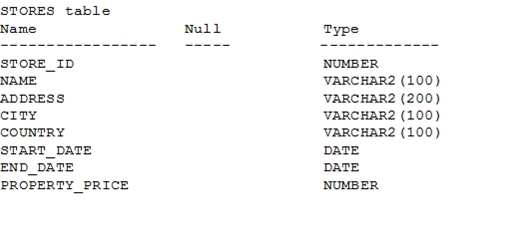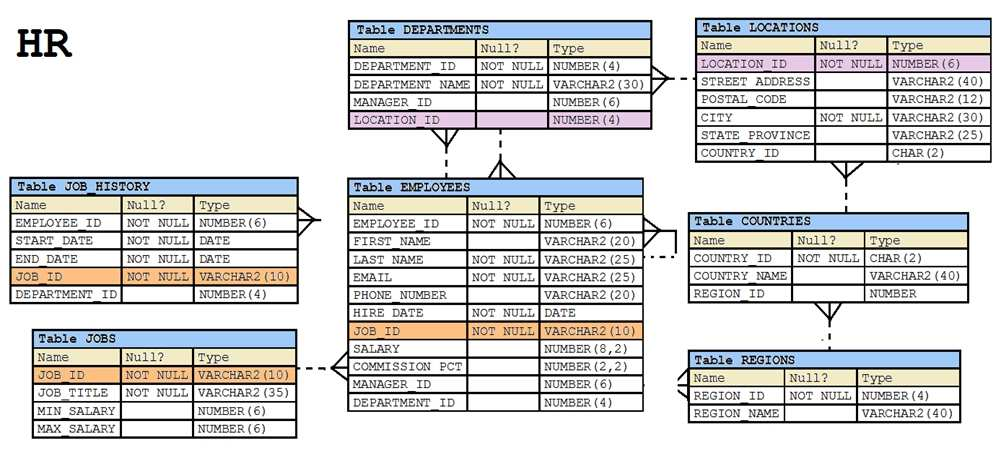File Info
| Exam | Oracle Datbase 12c SQL |
| Number | 1z0-071 |
| File Name | Oracle.1z0-071.Pass4Sure.2019-10-11.152q.vcex |
| Size | 13 MB |
| Posted | Oct 11, 2019 |
| Download | Oracle.1z0-071.Pass4Sure.2019-10-11.152q.vcex |
How to open VCEX & EXAM Files?
Files with VCEX & EXAM extensions can be opened by ProfExam Simulator.
Coupon: MASTEREXAM
With discount: 20%





Demo Questions
Question 1

View the exhibit and examine the structure of the STORES table.

You must display the NAME of stores along with the ADDRESS, START_DATE, PROPERTY_PRICE, and the projected property price, which is 115% of property price.
The stores displayed must have START_DATE in the range of 36 months starting from 01-Jan-2000 and above.
Which SQL statement would get the desired output?
- SELECT name, concat (address| | ','| |city| |', ', country) AS full_address,start_date,property_price, property_price*115/100FROM storesWHERE MONTHS_BETWEEN (start_date, '01-JAN-2000') <=36;
- SELECT name, concat (address| | ','| |city| |', ', country) AS full_address,start_date,property_price, property_price*115/100FROM storesWHERE TO_NUMBER(start_date-TO_DATE('01-JAN-2000','DD-MON-RRRR')) <=36;
- SELECT name, address||', '||city||', '||country AS full_address, start_date,property_price, property_price*115/100FROM storesWHERE MONTHS_BETWEEN(start_date,TO_DATE('01-JAN-2000','DD-MON-RRRR')) <=36;
- SELECT name, concat (address||','| |city| |', ', country) AS full_address,start_date,property_price, property_price*115/100FROM storesWHERE MONTHS_BETWEEN (start_date, TO_DATE('01-JAN-2000','DD-MON-RRRR')) <=36;
Correct answer: D
Question 2
The BOOKS_TRANSACTIONS table exists in your database.
SQL>SELECT * FROM books_transactions ORDER BY 3;
What is the outcome on execution?
- The execution fails unless the numeral 3 in the ORDER BY clause is replaced by a column name.
- Rows are displayed in the order that they are stored in the table only for the three rows with the lowest values in the key column.
- Rows are displayed in the order that they are stored in the table only for the first three rows.
- Rows are displayed sorted in ascending order of the values in the third column in the table.
Correct answer: D
Question 3

Examine the command:

What does ON DELETE CASCADE imply?
- When the BOOKS table is dropped, the BOOK_TRANSACTIONS table is dropped.
- When the BOOKS table is dropped, all the rows in the BOOK_TRANSACTIONS table are deleted but the table structure is retained.
- When a row in the BOOKS table is deleted, the rows in the BOOK_TRANSACTIONS table whose BOOK_ID matches that of the deleted row in the BOOKS table are also deleted.
- When a value in the BOOKS.BOOK_ID column is deleted, the corresponding value is updated in the BOOKS_TRANSACTIONS.BOOK_ID column.
Correct answer: C
Question 4

View the exhibit and examine the structure of the EMPLOYEES table.

You want to display all employees and their managers having 100 as the MANAGER_ID. You want the output in two columns: the first column would have the
LAST_NAME of the managers and the second column would have LAST_NAME of the employees.
Which SQL statement would you execute?
- SELECT m.last_name "Manager", e.last_name "Employee"FROM employees m JOIN employees eON m.employee_id = e.manager_idWHERE m.manager_id = 100;
- SELECT m.last_name "Manager", e.last_name "Employee"FROM employees m JOIN employees eON m.employee_id = e.manager_idWHERE e.manager_id = 100;
- SELECT m.last_name "Manager", e.last_name "Employee"FROM employees m JOIN employees eON e.employee_id = m.manager_idWHERE m.manager_id = 100;
- SELECT m.last_name "Manager", e.last_name "Employee"FROM employees m JOIN employees eWHERE m.employee_id = e.manager_id AND e.manager_id = 100
Correct answer: B
Question 5
Which three statements are true about multiple-row subqueries?
- They can contain a subquery within a subquery.
- They can return multiple columns as well as rows.
- They cannot contain a subquery within a subquery.
- They can return only one column but multiple rows.
- They can contain group functions and GROUP BY and HAVING clauses.
- They can contain group functions and the GROUP BY clause, but not the HAVING clause.
Correct answer: ABE
Question 6
Evaluate the following SQL statements that are issued in the given order:
CREATE TABLE emp
(emp_no NUMBER(2) CONSTRAINT emp_emp_no_pk PRIMARY KEY,
ename VARCHAR2(15),
salary NUMBER (8,2),
mgr_no NUMBER(2) CONSTRAINT emp_mgr_fk REFERENCES emp(emp_no));
ALTER TABLE emp
DISABLE CONSTRAINT emp_emp_no_pk CASCADE;
ALTER TABLE emp
ENABLE CONSTRAINT emp_emp_no_pk;
What would be the status of the foreign key EMP_MGR_PK?
- It would remain disabled and can be enabled only by dropping the foreign key constraint and recreating it.
- It would remain disabled and has to be enabled manually using the ALTER TABLE command.
- It would be automatically enabled and immediate.
- It would be automatically enabled and deferred.
Correct answer: B
Question 7
Which three statements are true regarding the data types? (Choose three.)
- The minimum column width that can be specified for a VARCHAR2 data type column is one.
- Only one LONG column can be used per table.
- A TIMESTAMP data type column stores only time values with fractional seconds.
- The BLOB data type column is used to store binary data in an operating system file.
- The value for a CHAR data type column is blank-padded to the maximum defined column width.
Correct answer: ABE
Explanation:
Question 8
Which three statements are true regarding subqueries? (Choose three.)
- Multiple columns or expressions can be compared between the main query and subquery.
- Subqueries can contain ORDER BY but not the GROUP BY clause.
- Main query and subquery can get data from different tables.
- Subqueries can contain GROUP BY and ORDER BY clauses.
- Main query and subquery must get data from the same tables.
- Only one column or expression can be compared between the main query and subquery.
Correct answer: ACD
Explanation:
References:http://docs.oracle.com/javadb/10.6.2.1/ref/rrefsqlj13658.html References:
http://docs.oracle.com/javadb/10.6.2.1/ref/rrefsqlj13658.html
Question 9
Which statement is true regarding the default behavior of the ORDER BY clause?
- In a character sort, the values are case-sensitive.
- NULL values are not considered at all by the sort operation.
- Only those columns that are specified in the SELECT list can be used in the ORDER BY clause.
- Numeric values are displayed from the maximum to the minimum value if they have decimal positions.
Correct answer: A
Question 10
Which statement is true about an inner join specified in a query’s WHERE clause?
- It only applies for equijoin conditions.
- It applies for equijoin and nonequijoin conditions.
- It requires column names to be the same in all tables being joined.
- It must have primary-key and foreign-key constraints defined on the join columns.
Correct answer: B

